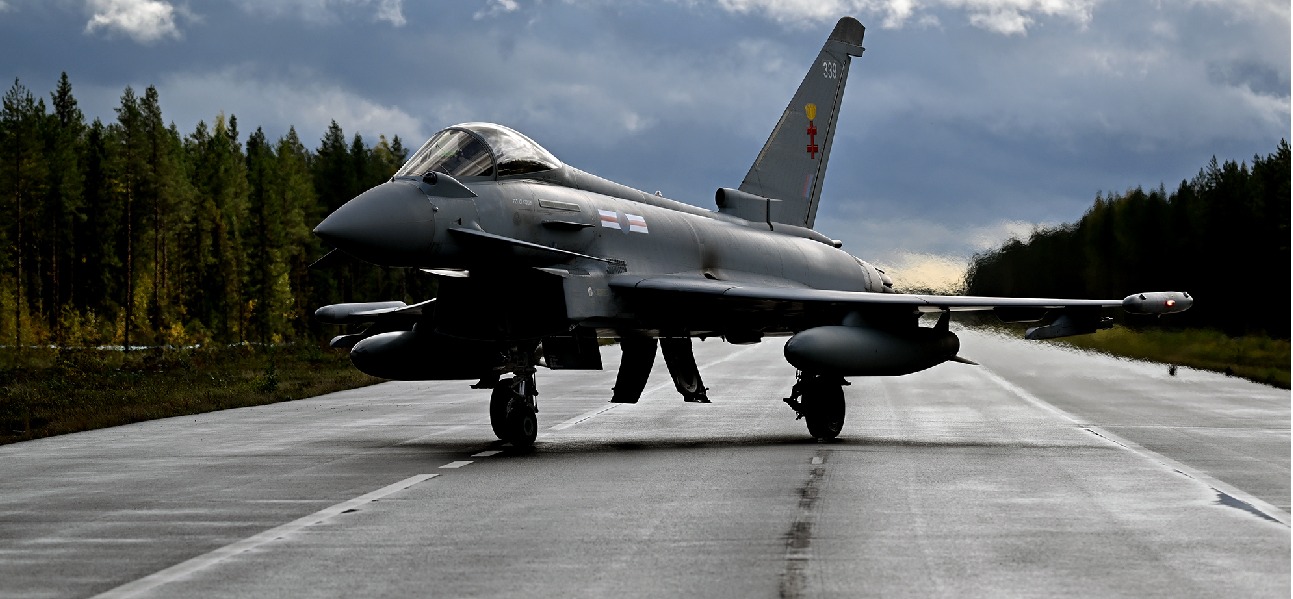In a significant milestone, a British Typhoon fighter jet conducted its first-ever landing on a Finnish road strip, highlighting the Royal Air Force’s capability to deploy its frontline assets effectively from dispersed locations.
The operation occurred on September 20 as part of the Baana 23 exercise in Tervo, Eastern Finland. The UK Defence Attaché in Finland and the Finnish Air Force made the announcement.
The Typhoon aircraft utilized in the operation belongs to RAF 41 Squadron, the Testing and Evaluation Squadron (TES) for the RAF’s Typhoon fleet. This squadron is stationed at RAF Coningsby in the United Kingdom.
The Royal Air Force executed the operation in collaboration with Karelia Air Command, a Finnish Air Force unit dedicated to safeguarding the airspace of Eastern and South-Eastern Finland.
Following its successful landing on the road, the Royal Air Force fighter underwent a hot refueling procedure at the turning point of the road base.
A hot refueling operation is a process in aviation where an aircraft safely lands and taxis to a designated fueling area. During this maneuver, the aircraft’s engines continue to run, enabling a seamless transition for the refueling procedure.
The ground crew promptly engages in fueling the aircraft while it remains in readiness. Once the fueling is completed, the plane resumes operations, taking off without a prolonged delay.

Royal Air Force Eurofighter Typhoons are participating for the first time in the Baana 23 exercise and are operating from the Rissala Air Base.
The Air Force road base exercise, Baana 23, is underway in Tervo, North-Savo, from September 18 to 22, 2023. Notably, this exercise features participation from aircraft belonging to allied nations, fostering international cooperation and training.
The Baana is an annual road-based exercise organized by the Finnish Air Force. The responsibility for leading this exercise rotates among different Air Force units each year, and currently, it is being overseen by the Karelia Air Command.
Renewed Focus On Road Operations
The first-ever landing on a Finnish road demonstrates the Royal Air Force’s deliberate effort to verify the readiness of its frontline assets.
The objective is to ensure they can effectively operate from dispersed and unconventional locations, including highways within the Nordic countries.
This training was standard practice during the Cold War, particularly in Central, Eastern, and Northern Europe. The looming threat of a Soviet attack on NATO air bases meant they could become unavailable within hours.
Consequently, training involving highway take-offs and landings became essential to military preparedness.
Following the Warsaw Pact’s collapse, highway take-offs and landings remained a routine feature in Finland and Sweden, given their geographical and geopolitical considerations.
However, this practice gradually diminished in frequency across the rest of Europe and the world as the threat landscape evolved and the nature of conflicts shifted.
In the wake of Russia’s invasion of Ukraine, NATO countries are again directing their attention toward staging road operations.
In July 2023, a senior Royal Air Force official disclosed plans to imminently showcase the capability of Eurofighter Typhoon FGR4s and Lockheed Martin F-35Bs to operate from roadways effectively.
This demonstration forms a crucial component of a broader distributed operations strategy, highlighting the military’s commitment to enhancing its operational agility and responsiveness in the face of Russian threats.
Nevertheless, implementing this strategy comes with additional costs, necessitating the acquisition of extra spare parts and training maintenance personnel.
Consequently, numerous air forces have shifted their focus towards optimizing the efficiency of their primary operating bases, where resources can be more effectively concentrated and managed.
The expenses associated with distributed operations have escalated with the growing sophistication of frontline aircraft like Typhoons and F-35Bs. These advanced aircraft demand meticulous care and maintenance, adding to the financial burden.
Such demonstrations are designed to scrutinize and assess the Royal Air Force’s ability to operate independently from its main operating bases for limited durations.
These tests also aim to identify potential shortcomings and improvement areas, ensuring that the RAF can maintain operational readiness and flexibility even in dispersed scenarios.
- Contact the author at ashishmichel(at)gmail.com
- Follow EurAsian Times on Google News